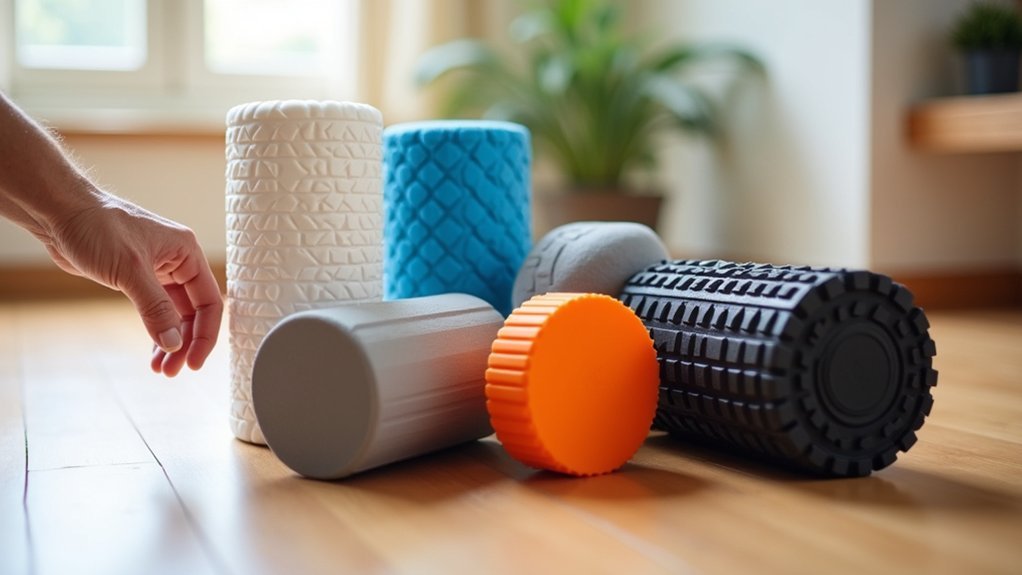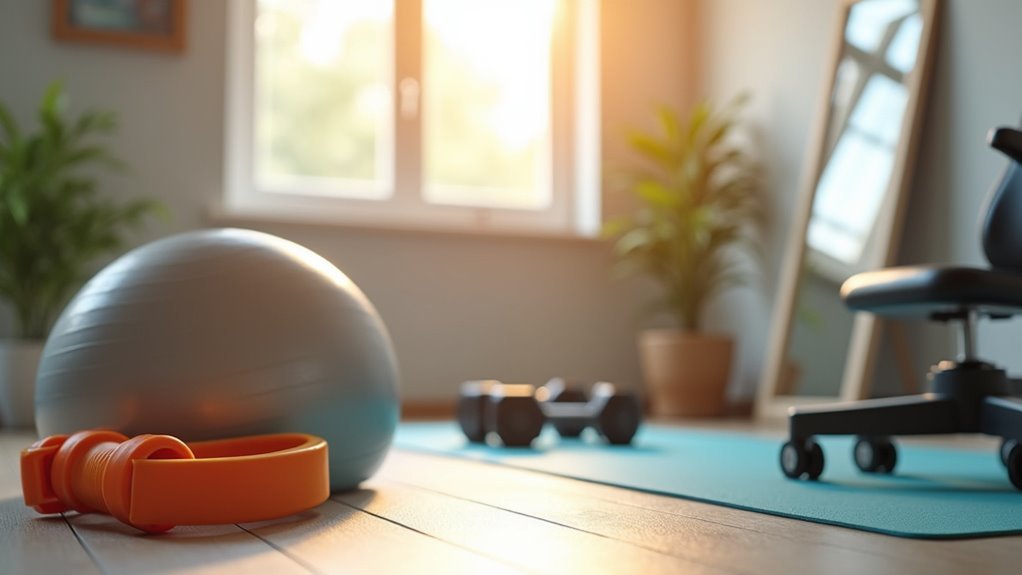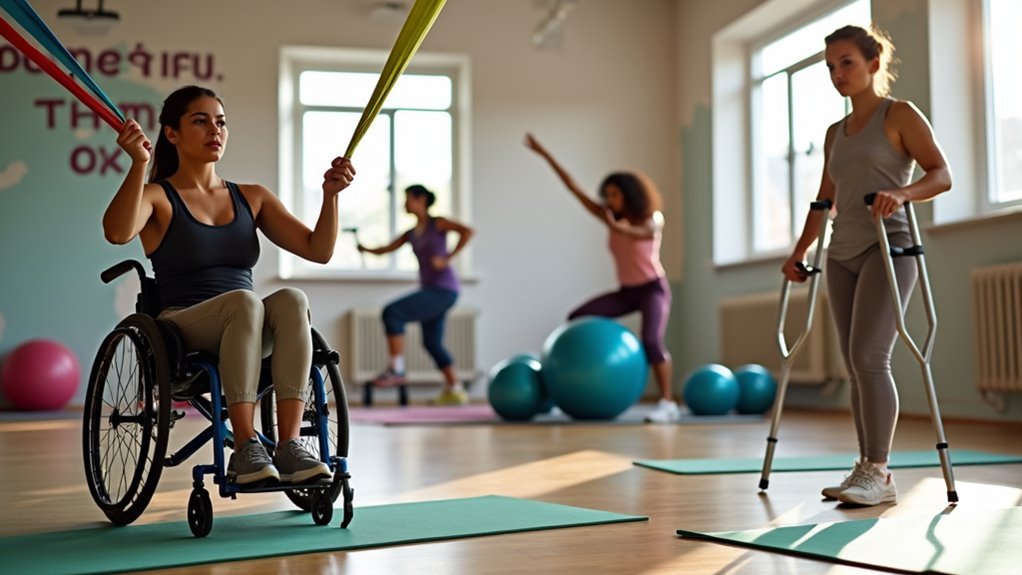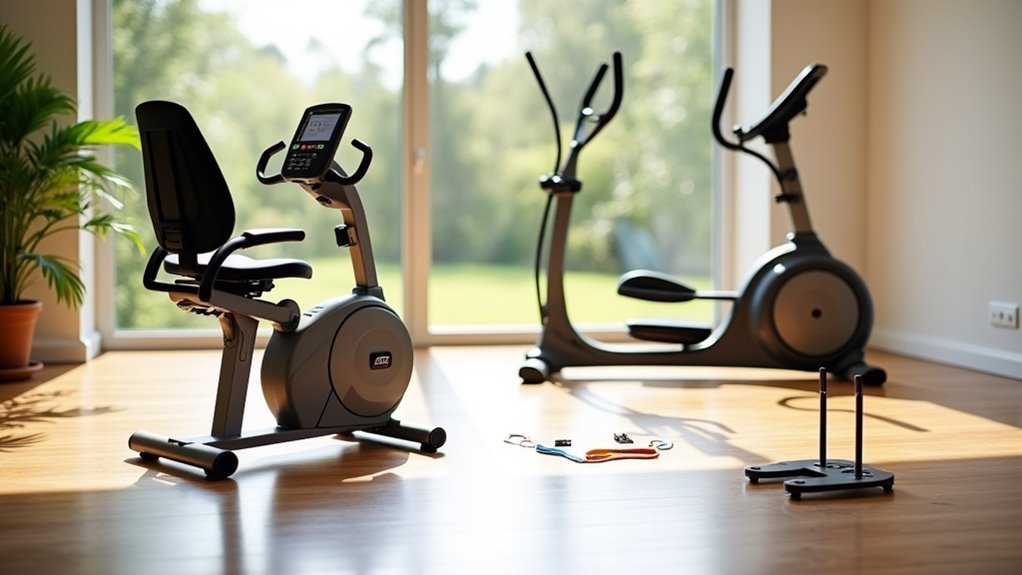As you age, your muscles need more recovery time and specialized care. You’ll find that foam rollers offer an effective solution for easing tension and improving mobility, but not all are created equal for senior users. Physical therapists consistently recommend specific models that address the unique needs of older adults—considering factors like firmness, texture, and ease of use. Discover which five foam rollers experts trust most for safe, effective relief that won’t stress your aging joints.
Oceanfoam Tidal Roller for Muscle Massage and Back Pain
The Oceanfoam Tidal Roller stands out as an excellent option for seniors seeking substantial muscle recovery, particularly those who’ve maintained an active lifestyle and need deeper tissue work.
At 20 x 5 inches, this black marbled roller targets larger muscle groups effectively. Its eco-conscious design features recycled foam with an algae-based outer layer. The ergonomic wave texture enhances relief for back, legs, and shoulders.
However, proceed with caution. You’ll want to start slowly as the firm density may cause mild bruising. Consider wearing thicker clothing during initial sessions until you’re accustomed to its professional-grade pressure.
Best For: Active seniors who need deeper tissue work for muscle recovery and have experience with firm foam rollers.
Pros:
- Made with eco-conscious recycled foam and algae-based materials
- Ergonomic wave texture effectively targets larger muscle groups like back, legs, and shoulders
- Professional-grade performance designed by sports medicine and physical therapy experts
Cons:
- Firm density may cause mild bruising, especially for beginners
- Some users find it uncomfortably firm during initial use
- Requires cautious approach and potentially wearing thicker clothing when starting
Roleo Leg Massager for Calf, Thighs & Arms Muscle Relief
Versatile and gentle on aging tissues, the Roleo Leg Massager offers seniors an effective self-massage solution that mimics professional techniques without requiring excessive strength or flexibility. You’ll appreciate its lightweight design for use at home or during travel.
The spring-loaded rollers provide adjustable pressure that targets specific muscle groups including calves, hamstrings, and arms. Simply roll up and down to improve circulation and alleviate soreness. For deeper relief, change the angle or use the roller ends on trigger points.
While some find the pressure intense on sensitive areas, many seniors report significant relief from muscle tightness and cramps with regular use.
Best For: Seniors looking for a gentle yet effective self-massage tool that can help with muscle relief in calves, thighs, and arms without requiring significant strength or flexibility.
Pros:
- Lightweight and portable design allows for easy use at home or while traveling
- Adjustable spring-loaded pressure system accommodates different comfort levels and targets specific muscle groups
- Versatile application that mimics professional massage techniques for improving circulation and alleviating muscle soreness
Cons:
- May provide too intense pressure for those with particularly sensitive areas or tissues
- Requires manual operation which might be tiring for some users
- Some seniors might find alternative massage tools more effective for their specific needs
Foam Roller for Deep Tissue Massage (Travel Size)
Seasoned travelers seeking senior-friendly recovery tools will appreciate this travel-sized foam roller’s impressive versatility. At just 12 x 4 inches and weighing only 2 ounces, it fits easily in your luggage without sacrificing effectiveness.
The expanded polypropylene foam provides firm pressure that’s ideal for releasing tension in your back, legs, and shoulders. You’ll find it particularly useful for targeting trigger points in larger muscle groups.
With a strong 4.2-star rating from over 800 customers, this compact roller delivers reliable relief. Though small, it’s durable enough for daily use, though some heavier individuals report minor denting over time.
Best For: Active seniors and frequent travelers who need targeted muscle relief on-the-go without carrying bulky recovery equipment.
Pros:
- Ultra-lightweight design (just 2 ounces) makes it incredibly portable for travel while maintaining effectiveness for deep tissue massage
- Compact 12 x 4 inch size fits easily in luggage or gym bags while still providing adequate surface area for larger muscle groups
- Versatile application across multiple body areas including back, legs, and shoulders with firm pressure for trigger point release
Cons:
- Some users report the logo design can affect comfort during certain rolling positions
- May develop dents over time with regular use by heavier individuals
- Smaller size might be less effective for those requiring more extensive muscle work or used to full-sized foam rollers
Yes4All High Density Half Round Foam Roller for Physical Therapy
Seniors seeking a stable, supportive option for therapy and recovery will find the Yes4All High Density Half Round Foam Roller particularly valuable. Its flat side rests firmly on the floor, providing stability that’s essential for balance-challenged users.
Available in multiple sizes (12-36 inches), this high-density EPP foam roller works wonderfully for spine relaxation and gentle stretching exercises. You’ll appreciate its versatility for Pilates, balance training, and physical therapy routines.
With a 4.5-star rating from over 2,700 reviews, it’s proven effective for mobility improvement. The roller’s firmness offers excellent support, though some may find it less yielding than softer options.
Best For: Seniors and individuals undergoing physical therapy who need a stable, supportive tool for gentle stretching, spine relaxation, and balance training exercises.
Pros:
- Available in multiple sizes (12-36 inches) to accommodate different exercises and user heights
- High-density EPP foam provides excellent support and durability for therapy routines
- Flat design ensures stability during use, making it safer for those with balance challenges
Cons:
- Very firm material with minimal give may be too hard for some users seeking more cushioning
- Limited color options (only black, red snow, and purple available)
- At 0.13 kilograms, the smaller sizes may be too lightweight for certain stability exercises
Amazon Basics High Density Foam Roller for Exercise and Recovery
The Amazon Basics High Density Foam Roller strikes an ideal balance between firmness and comfort, making it particularly valuable for seniors with tender muscles requiring targeted relief. At 18 inches long and 6 inches wide, it’s versatile enough to target various muscle groups from back to legs.
With over 113,000 positive reviews and a 4.6-star rating, this polypropylene roller maintains its shape during use while molded edges enhance comfort during therapy sessions. Weighing just 0.27kg, you’ll find it easy to reposition between exercises.
At its budget-friendly price point, it’s an excellent starter option if you’re new to foam rolling for post-exercise recovery.
Best For: Seniors and fitness enthusiasts seeking an affordable, firm foam roller for muscle recovery, tension relief, and rehabilitation exercises.
Pros:
- High-density polypropylene material maintains its shape while providing effective deep tissue massage for various muscle groups
- Lightweight design (0.27kg) makes it easy to reposition during workouts or therapy sessions
- Exceptional value proposition backed by over 113,000 positive reviews and a 4.6-star rating
Cons:
- Some users report durability issues after extended use, suggesting it may not be ideal for long-term investment
- Firmness may be too intense for beginners or those seeking a softer rolling experience
- Basic design lacks textured surfaces or additional features found in premium foam rollers
Factors to Consider When Choosing the Most Effective Foam Rollers for Senior Muscle Recovery
When choosing a foam roller for senior recovery needs, you’ll want to weigh multiple factors including firmness against comfort and the roller’s size and portability. The texture and surface design affect how deeply the roller targets muscle tissue, while eco-friendly materials offer benefits beyond just your health. Therapeutic design features like contoured shapes or vibration capabilities can profoundly improve your recovery process and accommodate age-specific mobility concerns.
Firmness vs. Comfort Balance
Finding the right balance between firmness and comfort stands as one of the most critical decisions you’ll face when selecting a foam roller for senior muscle recovery. While firmer rollers deliver deeper pressure that effectively relieves tight muscles, they can cause discomfort if used improperly, especially on sensitive areas.
For seniors, it’s best to start with softer options and gradually progress to firmer varieties as tolerance builds. Look for rollers with ergonomic designs or textured surfaces that enhance comfort while still providing necessary pressure. This approach helps prevent bruising or pain that overly firm rollers might cause.
Always match the roller’s firmness to your physical condition and experience level. If you’re new to foam rolling, gentler options will help you avoid overwhelming soreness while still supporting your muscle recovery needs.
Size and Portability
Two critical aspects of foam roller selection for seniors are size and portability, which directly impact usability and convenience. When choosing the right roller, consider length options carefully—larger models (18+ inches) provide broader coverage for major muscle groups, while compact 12-inch versions offer easier handling and storage.
Weight is equally important; ultra-lightweight options (around 2 ounces) prevent unnecessary strain during use and transport. A diameter of approximately 6 inches typically provides effective muscle targeting without becoming unwieldy for seniors with limited strength.
For those who attend physical therapy sessions or exercise classes, prioritize rollers that fit easily into bags and require minimal storage space. The ideal foam roller combines comfortable dimensions with practical portability, allowing you to maintain your recovery routine whether at home or on the go.
Texture and Surface Design
The texture and surface design of a foam roller greatly impact both comfort and effectiveness for senior users. When selecting a roller, you’ll find options ranging from smooth surfaces to ergonomic wave patterns that target larger muscle groups with precision.
High-density rollers provide firm support for deep tissue massage and myofascial release—beneficial if you’re dealing with persistent muscle tightness. However, if you have sensitive skin or are new to foam rolling, smoother surfaces may prevent discomfort and bruising.
Textured rollers can mimic various massage techniques, giving you versatility in your recovery routine. This is particularly valuable as you may need different pressure types for different body areas.
Remember to prioritize your comfort level—too firm may cause pain, while too soft might not deliver the therapeutic benefits you’re seeking.
Eco-Friendly Material Considerations
Beyond the roller’s texture and feel against your skin, the materials from which it’s made carry significant implications for both your health and our planet. Many manufacturers now offer sustainable options featuring recycled foam or innovative algae-based layers that deliver effective muscle recovery while reducing environmental impact.
For seniors especially, eco-conscious foam rollers provide dual benefits: they’re typically free from toxic chemicals that could irritate sensitive skin during recovery sessions, and they align wellness practices with environmental responsibility. These biodegradable alternatives break down more naturally after disposal, minimizing landfill waste.
When shopping for your recovery tools, look for labels indicating recycled content or sustainable manufacturing processes. You’ll support the growing market for environmentally responsible fitness equipment while ensuring your muscle recovery routine remains both effective and earth-friendly.
Therapeutic Design Features
When selecting a foam roller for senior muscle recovery, therapeutic design features greatly impact both comfort and effectiveness. Look for ergonomic designs that provide targeted pressure to sensitive areas, enhancing muscle relief while promoting relaxation. High-density foam delivers firm support for deep tissue massage, effectively alleviating soreness and improving flexibility.
Consider rollers with varied textures, such as wave patterns, which mimic different massage techniques and release muscle tension more thoroughly. You’ll want adjustable pressure settings or designs that allow you to control intensity, accommodating different pain thresholds as you age.
Prioritize lightweight, portable options you can easily handle and incorporate into your daily routine. This guarantees consistent use, which is key to ongoing muscle recovery and maintaining mobility throughout your senior years.
Ease of Use
Selecting a foam roller that’s easy to maneuver becomes paramount for seniors seeking effective muscle recovery without adding strain. You’ll want to prioritize lightweight, portable options that you can easily transport between rooms or to physical therapy sessions.
Look for compact or travel-sized rollers that won’t overwhelm you with their bulk—these are ideal if you have limited strength in your hands or arms. Rollers with ergonomic designs conform better to your body’s natural contours, making the experience more comfortable and effective.
Consider models with adjustable pressure settings or softer materials that allow you to control the intensity of your muscle release. Additionally, choose rollers that are simple to clean with a quick wipe-down, as maintaining proper hygiene shouldn’t be a complicated process after your recovery sessions.
Targeting Specific Pain Areas
Three key considerations emerge when targeting specific pain areas with foam rollers in your senior recovery routine. First, look for specialized designs like half-round or textured rollers that can effectively reach problem spots in your back, legs, and shoulders where pain commonly occurs.
Second, prioritize ergonomic features that enhance comfort while allowing precise pressure on specific tension points. This is especially important if you’re dealing with localized discomfort that standard rollers might not adequately address.
Finally, match roller density to your needs—high-density options provide deeper pressure for stubborn knots, while varied-texture rollers can replicate different massage techniques such as effleurage. Understanding which muscle groups require attention—whether it’s tight calves or sore hamstrings—will help you select rollers specifically designed for those areas, maximizing your recovery effectiveness.
Durability and Maintenance
The lifespan of your foam roller directly impacts both your recovery routine and budget as a senior athlete. When shopping, prioritize high-density materials like EPP foam or polypropylene that resist deformation even with regular use. These durable options maintain their shape and effectiveness longer than softer alternatives.
Keep your investment in prime condition by cleaning it after each session. Most quality rollers feature easy-to-clean surfaces that prevent bacteria buildup and extend usability. Look for models with molded edges or ergonomic designs that provide extra comfort while reducing injury risk.
Consider the weight factor carefully—you’ll want a roller that’s substantial enough to provide adequate pressure but light enough to handle and store easily. Finding the right balance between firmness and comfort guarantees you’ll continue using your roller consistently for maximum muscle recovery benefits.
Frequently Asked Questions
How Long Should Seniors Foam Roll per Session?
You’ll want to foam roll for 10-15 minutes per session. Don’t rush the process. Start with 30-60 seconds per muscle group, and listen to your body. You’re in control of the pressure applied.
Can Foam Rolling Interact Negatively With Blood-Thinning Medications?
Yes, foam rolling can potentially interact with blood thinners by increasing bruising risk. If you’re on anticoagulants, talk to your doctor before starting a foam rolling routine to guarantee it’s safe for you.
When Is Foam Rolling Contraindicated for Seniors?
Don’t foam roll if you’ve got acute injuries, blood clotting disorders, recent surgeries, advanced osteoporosis, or skin conditions. You’ll also want to avoid it when taking blood thinners or if you’re experiencing severe pain.
How Often Should Seniors Replace Their Foam Rollers?
You should replace your foam roller every 8-12 months if used regularly. Look for signs of wear like flattening, cracks, or reduced firmness. Don’t wait until it’s completely broken to upgrade.
Can Foam Rolling Help With Arthritis Symptoms?
Foam rolling can help with arthritis symptoms by improving circulation and reducing muscle tension around affected joints. You’ll benefit most when you combine it with your doctor-approved exercise routine and proper technique.





Leave a Reply